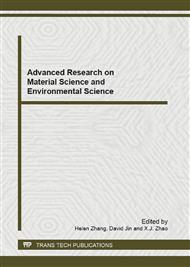p.304
p.309
p.314
p.318
p.323
p.328
p.333
p.337
p.343
Study of Analysis Technology of Organic Carbon in Sediment as Powder Materials with Ozonation Chemiluminescence Method
Abstract:
A method for rapid analysis on-site of organic carbon in sediment powder materials is recommended. It is based on researches on the phenomenon of chemiluminescence of organic carbon in sediment powder materials reacting with ozone. A Chemiluminescence kinetics curve was obtained by using an home-made experimental instrument, and used to analyze content and characteristics of the organic carbon in sediment powder materials, such as the proportion of hard oxidation , easy oxidation and middling stabilization. Effectiveness of the method was verified comparing its results with those of the existing detection method. Based on the finding that sediments powder materials varied sharply in chemiluminescence feature from type to type, a concept of “organic carbon fingerprint” is recommended.
Info:
Periodical:
Pages:
343-347
Citation:
Online since:
June 2012
Authors:
Price:
Сopyright:
© 2012 Trans Tech Publications Ltd. All Rights Reserved
Share:
Citation:


